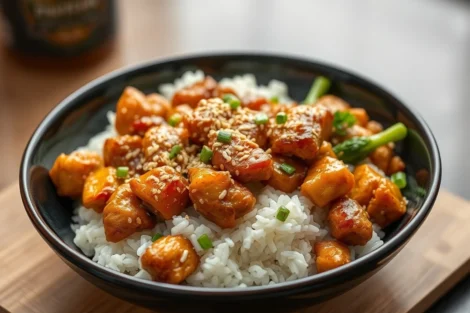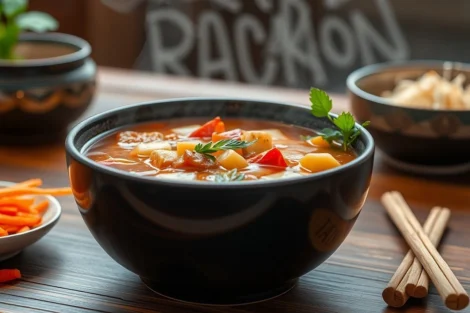If you’re seeking an exquisite dining experience that brings the rich flavors of Cantonese and Chinese cuisine to your table, look no further than Cantonese Kitchen in Springfield, Missouri. This restaurant promises a delightful journey into the heart of traditional Cantonese cooking.
Restaurant Location and Contact Information
- Address: 839 N Glenstone Ave, Springfield, MO 65802, United States
- Phone: +1 417-771-5621
- Price Range: $1-$10 per person
- Hours of Operation: Open until 22:00
Ambiance and Available Services
- Rating: ⭐ 4.5 (122 reviews)
- Service Options:
- ✅ Dine-in
- ✅ Takeout
- ✅ Order Food Delivery
- Accessibility:
- ✅ Wheelchair-accessible seating
- ✅ Wheelchair-accessible restroom
Menu Highlights and Signature Dishes
At Cantonese Kitchen, you can indulge in a variety of authentic and flavorful dishes, including:
- Fried Wontons: Crispy on the outside, tender on the inside, and served with a delightful dipping sauce.
- Rice and Vegetables: A perfect balance of grains and greens, showcasing the simplicity and elegance of Cantonese cuisine.
Ambiance and Customer Experience
Cantonese Kitchen features a warm and inviting atmosphere with a hint of traditional Chinese decor. Guests can enjoy a comfortable dining experience, whether they choose to dine in or opt for takeout. The staff is known for their friendly and attentive service, ensuring that every guest feels welcome.
Peak Hours and Popular Dishes
- Best Visiting Times: Lunch and Dinner
- Famous Dishes: Fried wontons, rice and vegetables, and various Cantonese specialties.
Why Should You Visit Cantonese Kitchen?
- Authentic Cantonese and Chinese flavors at an affordable price.
- Friendly service and comfortable dining ambiance.
- Convenient options for dine-in, takeout, and delivery.
Cantonese Kitchen in Springfield, Missouri, is more than just a restaurant; it’s a culinary journey that captures the essence of Cantonese cooking. Whether you’re a local or just passing through, this charming eatery promises a memorable dining experience.
Planning your next meal out? Make sure to visit Cantonese Kitchen for a taste that will leave you coming back for more!
Table of Contents

The Ultimate Guide to Sesame Chicken with Rice: Bring Restaurant-Style Flavor Home
There’s something magical about the perfect plate of sesame chicken with rice. For many, it brings back memories of dining at a favorite Cantonese kitchen, savoring the sweet and savory flavors that define this classic dish. Whether it’s the crispy chicken coated in glossy sesame sauce or the fluffy rice soaking up every bite of flavor, sesame chicken is a comfort food that connects cultures and cravings. This guide will help you recreate that beloved restaurant-style experience at home, whether you’re cooking for family, friends, or a cozy solo dinner.
What Makes Sesame Chicken a Restaurant Favorite?
- History of Sesame Chicken
- Origins in Cantonese and Chinese-American cuisine.
- How it became a staple in Chinese restaurants globally.
- Mention of adaptations and regional variations.
- Why It’s So Popular
- The balance of sweet, savory, and umami flavors.
- Its versatility: perfect for casual dining or special occasions.
- The visual appeal of golden crispy chicken with sesame seeds.
Ingredients Breakdown: Creating Authentic Flavors
- Key Ingredients for Sesame Chicken
- Chicken thighs vs. chicken breast: which works best and why.
- Cornstarch and flour: the secret to crispiness.
- Soy sauce, honey, and sesame oil for the sauce.
- Optional: chili flakes for a spicy kick.
- Perfect Rice Pairings
- Types of rice to complement sesame chicken (e.g., jasmine, brown rice).
- Cooking tips for fluffy, non-sticky rice.
- Ingredient Substitutions
- Gluten-free options.
- Vegetarian alternatives using tofu or cauliflower.
Step-by-Step: How to Make Sesame Chicken with Rice
- Preparation
- Prepping the chicken: marinating for flavor.
- Making the sauce: balancing sweetness, saltiness, and tang.
- Cooking Process
- Frying chicken to golden perfection.
- Achieving the perfect sauce consistency.
- Combining chicken and sauce: tips for even coating.
- Plating and Presentation
- Tips for restaurant-style plating.
- Garnishing with sesame seeds and scallions.
Nutritional Insights and Healthier Variations
- Nutritional Overview
- Approximate calorie count for a standard serving.
- Breakdown of macronutrients (protein, carbs, fats).
- Health-Conscious Modifications
- Air-frying or baking chicken for reduced fat content.
- Using brown rice or quinoa instead of white rice.
- Lower-sodium sauce options.
Pairing Suggestions: Drinks and Sides
- Beverage Pairings
- Traditional pairings like jasmine tea.
- Modern options: light beers or sparkling water with citrus.
- Side Dishes
- Classic: egg rolls, wonton soup, or steamed vegetables.
- Creative: Asian-style slaw or spicy edamame.
Cantonese Kitchen Spotlight: Inspiration from Restaurant Menus
- Restaurant Inspiration
- How Cantonese restaurants perfect sesame chicken.
- Techniques and tips learned from professional kitchens.
- Dishes to Try Next
- Similar Cantonese classics like General Tso’s chicken or orange chicken.
FAQs About Sesame Chicken with Rice
Q: What’s the difference between sesame chicken and General Tso’s chicken?
A: Sesame chicken has a sweeter, sesame-infused sauce, while General Tso’s chicken is spicier with a tangy edge.
Q: Can I make sesame chicken without frying?
A: Yes, you can bake or air-fry the chicken for a healthier alternative.
Q: What’s the best rice to serve with sesame chicken?
A: Jasmine rice is the most common choice due to its fragrant, slightly sticky texture.
Q: How do I store and reheat sesame chicken with rice?
A: Store in an airtight container in the fridge for up to 3 days. Reheat in a skillet to maintain crispiness.

Sweet and Sour Chicken: Your Ultimate Guide to Mastering a Cantonese Kitchen Favorite
Sweet and sour chicken is more than just a dish—it’s a sensory journey that transcends borders. The tangy aroma of vinegar, the sweetness of pineapple, and the crispy bite of perfectly cooked chicken create a harmonious balance of flavors that has delighted diners worldwide. Whether you’re reminiscing about a cherished meal at your favorite restaurant or discovering this Cantonese kitchen staple for the first time, this dish offers comfort and excitement in every bite.
Why Sweet and Sour Chicken is a Global Favorite
- The Origins of Sweet and Sour Chicken
- Roots in Cantonese cuisine: traditional sweet and sour sauce paired with various proteins.
- How it evolved into a staple of Chinese-American and international menus.
- What Makes It Irresistible
- Unique balance of sweet, tangy, and savory flavors.
- Versatility: perfect for casual dinners or elegant meals.
- A colorful, vibrant dish that appeals visually as well as gastronomically.
Ingredients That Define Sweet and Sour Chicken
- Core Ingredients for the Dish
- Chicken: choosing the right cut for texture and flavor (breast vs. thigh).
- Bell peppers, pineapple, and onions: the perfect vegetable medley.
- Sweet and sour sauce: balancing ketchup, vinegar, sugar, and soy sauce.
- Key Variations
- Using pork, shrimp, or tofu as protein alternatives.
- Adjusting sweetness or acidity to suit personal tastes.
- Ingredient Substitutions
- Gluten-free sauces and cornstarch for dietary needs.
- Healthier alternatives like honey instead of sugar.
How to Make Sweet and Sour Chicken at Home
- Preparation Essentials
- Marinating chicken for flavor and tenderness.
- Chopping vegetables for even cooking.
- Cooking Steps
- Achieving the perfect crispy coating for the chicken.
- Preparing the sweet and sour sauce: tips for the ideal consistency.
- Combining chicken, vegetables, and sauce for a cohesive dish.
- Pro Tips for Success
- Using a wok for even heat distribution.
- How to avoid soggy chicken when combining with the sauce.
Restaurant vs. Homemade Sweet and Sour Chicken
- What Sets Restaurant Dishes Apart
- Professional techniques like double frying for extra crunch.
- The use of specialized ingredients or equipment.
- Benefits of Making It at Home
- Customization: control over sweetness, spice, and portion sizes.
- Cost savings and the joy of cooking a beloved dish yourself.
Healthier Approaches to Sweet and Sour Chicken
- Nutrition Facts
- Caloric breakdown of a typical serving of sweet and sour chicken.
- Sodium, sugar, and fat content: what to watch for.
- Health-Conscious Tweaks
- Air-frying or baking chicken for lower fat content.
- Using brown rice, quinoa, or cauliflower rice as a side.
- Reducing sugar in the sauce or replacing it with natural sweeteners.
Pairing Sweet and Sour Chicken with Sides and Drinks
- Classic Pairings
- Steamed white rice or fried rice.
- Spring rolls, dumplings, or hot and sour soup.
- Beverage Suggestions
- Traditional Chinese teas (e.g., jasmine or oolong).
- Modern pairings: sparkling water with citrus or a light, fruity wine.
Cantonese Kitchen Secrets: Perfecting Sweet and Sour Chicken
- Tips from Cantonese Restaurants
- Using fresh, high-quality ingredients for bold flavors.
- How to achieve that iconic glossy finish on the sauce.
- Inspiration for Future Dishes
- Similar Cantonese classics like lemon chicken or orange beef.
- Expanding your repertoire with authentic Chinese recipes.
FAQs About Sweet and Sour Chicken
Q: Is sweet and sour chicken authentic Chinese food?
A: While its roots are in Cantonese cuisine, the version we know today has been adapted to suit Western tastes.
Q: How do I make sweet and sour chicken crispy?
A: Use cornstarch in the coating and fry the chicken in hot oil, ensuring it’s cooked in small batches.
Q: Can I make sweet and sour chicken healthier?
A: Yes! Bake or air-fry the chicken, reduce sugar in the sauce, and use whole-grain or low-carb sides.
Q: What’s the difference between sweet and sour chicken and orange chicken?
A: Sweet and sour chicken has a tangy, tomato-based sauce, while orange chicken features a sweeter, citrus-based glaze.
Q: How do I store and reheat sweet and sour chicken?
A: Store leftovers in an airtight container in the fridge for up to 3 days. Reheat in a skillet or air fryer to restore crispiness.

Hot and Sour Soup: A Comforting Cantonese Kitchen Classic for Every Season
Picture this: a steaming bowl of hot and sour soup on a cold evening, its tantalizing aroma filling the air. For many, this dish evokes memories of family gatherings at their favorite Cantonese restaurant or the comforting warmth of home-cooked meals. Its perfect balance of spice and tang, paired with the richness of its ingredients, makes hot and sour soup a global favorite. Whether you’re new to this dish or a lifelong fan, this guide will explore everything you need to know about making and enjoying this Cantonese kitchen staple.
What Makes Hot and Sour Soup So Special?
- Origins and Cultural Significance
- Roots in Cantonese and regional Chinese cuisine.
- Evolution into a global restaurant favorite.
- Symbolism: a dish often associated with balance and harmony.
- Why It’s Loved Worldwide
- A perfect blend of contrasting flavors—spicy, tangy, savory.
- Versatility as an appetizer or standalone meal.
- Comforting yet energizing: ideal for any occasion.
Ingredients That Define Hot and Sour Soup
- Core Ingredients
- Proteins: pork, chicken, tofu, or a combination.
- Vegetables: bamboo shoots, mushrooms, and scallions.
- Flavor enhancers: soy sauce, vinegar, white pepper, and chili oil.
- Regional Variations
- Cantonese style vs. Szechuan style: differences in heat levels and seasonings.
- Vegetarian and vegan adaptations with plant-based proteins.
- Ingredient Substitutions
- Gluten-free options for soy sauce and thickening agents.
- Adjusting spice levels to suit various palates.
How to Make Authentic Cantonese Hot and Sour Soup
- Preparation Steps
- Selecting fresh, high-quality ingredients.
- Preparing proteins and vegetables for even cooking.
- Cooking Process
- Sautéing aromatics for a flavor-packed base.
- Building the broth: balancing sourness with vinegar and heat with white pepper.
- Thickening with cornstarch: achieving the perfect consistency.
- Tips for Success
- Using a wok for enhanced flavor.
- Timing additions for tender vegetables and perfectly cooked proteins.
Health Benefits of Hot and Sour Soup
- Nutritional Highlights
- Low-calorie yet nutrient-rich: vitamins, protein, and minerals.
- Immune-boosting ingredients: ginger, garlic, and mushrooms.
- Diet-Friendly Options
- Keto-friendly versions with fewer carbs.
- Plant-based adaptations for vegans.
- Scientific Insights
- Studies on the health benefits of spicy foods.
- Antioxidant properties of ingredients like mushrooms and vinegar.
Hot and Sour Soup in the Cantonese Kitchen
- Restaurant Techniques
- How professional chefs create complex flavors.
- The role of presentation: garnishing with scallions or sesame oil.
- Homemade vs. Restaurant
- Benefits of homemade soup: customizable spice levels and dietary adjustments.
- The joy of recreating a restaurant-quality dish at home.
Pairing Hot and Sour Soup with Other Cantonese Dishes
- Complementary Appetizers
- Spring rolls, dumplings, or steamed buns.
- Light salads with Asian-inspired dressings.
- Main Courses
- Sweet and sour chicken, kung pao beef, or fried rice.
- Vegetarian stir-fries with bold Cantonese flavors.
- Beverage Pairings
- Traditional teas: jasmine or green tea.
- Modern twists: ginger ale or lightly spiced cocktails.
Mastering the Art of Hot and Sour Soup
- Pro Tips for Home Cooks
- Balancing spice and tang: taste-testing as you cook.
- Using homemade stock for a richer flavor profile.
- Inspiration for Experimentation
- Adding personal touches like shrimp or bean sprouts.
- Exploring fusion variations with global ingredients.
FAQs About Hot and Sour Soup
Q: What makes hot and sour soup “hot” and “sour”?
A: The “hot” comes from white pepper and chili oil, while the “sour” is from vinegar.
Q: Is hot and sour soup healthy?
A: Yes, it’s low in calories and rich in nutrients, especially when loaded with fresh vegetables and lean protein.
Q: Can I make hot and sour soup vegetarian or vegan?
A: Absolutely! Substitute meat with tofu and use vegetable stock for the base.
Q: How do I thicken hot and sour soup?
A: Cornstarch mixed with water is the most common thickening agent.
Q: Can I store and reheat hot and sour soup?
A: Yes, store it in an airtight container in the fridge for up to 3 days. Reheat gently on the stove to avoid overcooking.

Soft Noodle Lo Mein: Exploring the Cantonese Kitchen Classic
There’s a comforting simplicity in a plate of soft noodle lo mein. The silky, stir-fried noodles coated in a savory sauce, mixed with fresh vegetables and tender proteins, create a symphony of flavors and textures. For many, it’s more than a dish—it’s a memory of shared meals, bustling restaurants, and a taste of tradition. Whether you’re enjoying it at your favorite Cantonese spot or crafting it in your kitchen, lo mein is the ultimate comfort food that transcends time and place.
What Is Soft Noodle Lo Mein?
- Defining Lo Mein
- The origins of the term: “Lo mein” means “tossed noodles” in Cantonese.
- Differences between lo mein and chow mein: texture, cooking methods, and ingredients.
- A Staple in Cantonese Cuisine
- Cultural significance as a versatile and celebratory dish.
- Popularity in restaurants worldwide and as a takeaway favorite.
The Core Ingredients of Soft Noodle Lo Mein
- Key Components of the Dish
- Noodles: Fresh egg noodles, their texture, and cooking methods.
- Proteins: Chicken, beef, shrimp, tofu, or a combination.
- Vegetables: Bok choy, carrots, mushrooms, and bean sprouts.
- Sauce: Soy sauce, oyster sauce, sesame oil, and a hint of sugar.
- Ingredient Variations
- Gluten-free noodle alternatives like rice noodles or zoodles.
- Vegan adaptations using plant-based proteins and sauces.
- Sourcing Ingredients
- Best places to buy authentic Cantonese ingredients.
- Tips for selecting fresh noodles and produce.
How to Make Soft Noodle Lo Mein at Home
- Preparation Steps
- Preparing the noodles: boiling and draining for perfect texture.
- Cutting vegetables and proteins for even cooking.
- Cooking Techniques
- The importance of a hot wok for quick and even stir-frying.
- Tossing noodles to coat them evenly in sauce without overcooking.
- Sauce Secrets
- Achieving balance: savory, slightly sweet, and aromatic flavors.
- Thickening the sauce for a glossy finish using cornstarch.
- Plating and Presentation
- Garnishing with sesame seeds or chopped scallions for added flavor and appeal.
- Serving suggestions: pairing with light soups or appetizers.
The Health Benefits of Soft Noodle Lo Mein
- Nutritional Insights
- Moderate calorie count and high versatility for balanced meals.
- Fiber from vegetables and protein-rich additions.
- Healthier Cooking Adjustments
- Reducing oil and sodium in sauces.
- Using whole-grain noodles or spiralized vegetable noodles.
- Dietary Adaptations
- Keto-friendly lo mein with zucchini noodles.
- Low-sodium and heart-healthy alternatives for soy and oyster sauces.
Lo Mein in the Cantonese Kitchen
- Restaurant Techniques for Perfect Lo Mein
- How chefs achieve wok hei (the “breath of the wok”) for smoky flavor.
- Consistency in noodle texture and sauce distribution.
- Homemade vs. Restaurant-Style Lo Mein
- Benefits of home cooking: cost-effective, customizable, and fresh.
- Recreating the restaurant experience in your kitchen.
Pairing Soft Noodle Lo Mein with Other Cantonese Dishes
- Classic Pairings
- Appetizers like egg rolls, crab rangoon, or dumplings.
- Side dishes: wonton soup or hot and sour soup.
- Complementary Beverages
- Traditional: oolong tea, jasmine tea, or chrysanthemum tea.
- Modern options: light cocktails or sparkling water with citrus.
- Dessert Ideas
- Sweet sesame balls, almond jelly, or mango pudding for a complete meal.
The Global Popularity of Lo Mein
- Lo Mein Around the World
- Regional adaptations in American Chinese, Malaysian, and Thai cuisines.
- Variations in ingredients and presentation styles.
- Statistics and Trends
- Growth of noodle dishes in the global restaurant industry.
- Consumer preferences for customizable noodle bowls.
FAQs About Soft Noodle Lo Mein
Q: What are soft noodles in lo mein made of?
A: Soft noodles are typically made from wheat flour and eggs, giving them a chewy texture ideal for stir-frying.
Q: How is lo mein different from chow mein?
A: Lo mein noodles are boiled and tossed with sauce, while chow mein noodles are fried for a crispy texture.
Q: Can I make lo mein gluten-free?
A: Yes! Use gluten-free noodles like rice noodles and replace soy sauce with tamari.
Q: What vegetables go best in lo mein?
A: Bok choy, bell peppers, carrots, broccoli, and mushrooms are popular choices.
Q: Can I store and reheat lo mein?
A: Absolutely. Store in an airtight container in the fridge for up to 3 days and reheat in a hot wok or skillet for best results.

